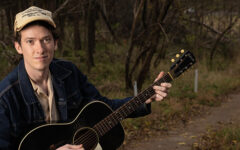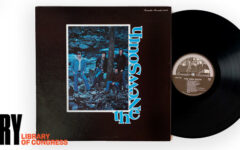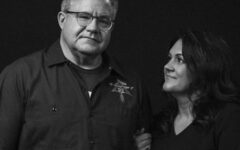
In this recurring column, bluegrass legend Doyle Lawson answers your questions about his storied musical career. To ask a question, either comment below, or send us your question by email.
Here we go again down memory lane of my musical journey. And I do want to make clear that if other people are involved in my recollection of events, theirs may differ somewhat in the way they may remember, and that’s understandable.
Hi Doyle.
You’ve played and endorsed a variety of mandolins over the decades, and you sounded good on all of them! Would you be willing to say a few words about luthier John Paganoni, his mandolins, and your relationship with him? And other mandolins you’ve liked.
Thanks
Dick Bowden in the Catskills
Dick Bowden, thanks for asking about the various mandolins that I have played and specifically asking about my dear friend John Paganoni and his mandolins. In the fall of 1972, the Country Gentlemen were still working the Shamrock Club, located at 33rd and M streets in Georgetown, DC every Tuesday and Wednesday. I had been playing an A-50 Gibson that had been converted by C.E. Ward and it was a great mandolin in the recording studio, but a little quiet onstage trying to compete with Bill Emerson’s power picking.
Anyway, the mandolin I was picking that night was a copy of an F-5 that I can’t remember much about, other than the scale was off on the fret board and I struggled from song to song to get as close to being in tune that was possible. Tom Morgan came to see us that night and brought a friend of his, and introduced me to John Paganoni who, like Tom, was in the USAF and had recently been promoted to Captain.
It was evident from the beginning of our conversation that John had a passion for bluegrass music and particularly the mandolin. A friendship that is as strong as ever began that night, and I felt as though I known John for years. After a bit he mentioned that he built mandolins and said that he noticed me struggling with the mandolin’s tuning. He took a look at it and assured me of what I had suspected, the scale was off a good bit.
John was stationed in Omaha, NE at the time, but told me that he would send one of his mandolins for me to look at. And so a few weeks later he was once again TDY back at Andrew’s AFB, and brought Pag #4 for me to see. During the first intermission I tuned it in the room we used for tuning, and took it onstage without saying anything to the other guys. Emerson intro’d the first song and I was doing my rhythm chop and he looked over at me in surprise. After the song he asked what mando was I picking, and I told it was John’s. He said, and I quote, “man that thing’s louder than my banjo!” The second intermission I told John that I had to have one of his mandolins, and in January 1973 he brought #9 to me and I still have it. It’s now on loan to the IBMM in Owensboro, KY.
This story has taken some time to tell and I’m trying to abbreviate as much as possible, but let me tell you about the man who is one of the best luthiers I know. John has a heart for people, and when you meet for the first time that big grin and warm personality will soon put you at ease. He’s a perfectionist in all things he does and leaves nothing undone. In addition to all of the mandolins he built he is also a model railroad enthusiast, and his construction of them is a wonder to behold. I could go on and on about John, but I’ll sum it up this way… for 50 years he has been a friend that is as close to me as a brother and you will never meet a finer person .
In the early 2000s I signed an agreement with Gibson USA to endorse a Doyle Lawson model F-5. The late Charlie Derrington was heading up the mandolin division and we worked closely (along with Danny Roberts) to cosmetically design something that would look a bit different, and I think it worked extremely well. After Charlie’s untimely death David Harvey stepped in to carry the torch for Gibson mandolins, and is doing a great job with it. He has been very creative in presenting varied looks of mandolins, yet remains true to the Gibson tradition. I always say that the name Gibson and bluegrass music go hand in hand, starting with Mr Bill’s ’23 Loar and Scruggs playing the Gibson banjo.
There are lots of good luthiers today, far too many to name individually, but I must mention the late Melvin Tucker whose Tucker mandolins were played by Dale Reno, Paul Williams, and myself for a while. Over in the Czech Republic you have Rosta Capek building great mandolins. Long time builder Randy Wood in Savannah, GA still does it just right.
Hi Doyle. You did one of the coolest things I’ve seen at a festival in my 40 plus years of going to them. It was in the ’80s (I think) at the CBA Father’s Day Festival in Grass Valley, CA. My band had played and, like other bands, had a terrible time with the sound guy. He was one of those who played with all the levels so that when you started a break your volume would come up by about the second or third measure when he figured out you were taking the next break. Frustrating for players and audience.
When your band was due to come up, you walked out on stage alone and set each mic’s volume by speaking in it and then telling the sound man where to set it, specifying that he was to leave it alone after it was set. When all the mics were where you wanted them, you told the sound guy to leave the booth and not return until your set was over. You got a huge hand from the audience before you ever played a note! And the admiration of every picker there. Oh, and you played a great set. Memorable!
Lloyd Foote
Well Lloyd, you’ve brought up a subject that still leaves me with nightmares! Not really, but it was always frustrating to be onstage and have to deal with an over zealous or a don’t give a #@*# sound person. And I admit that I was pretty hard on sound techs back before I could afford to have one who would be with us at every concert. In all fairness to sound companies hired to provide sound for multiple groups at a two or three day event, it is an extremely difficult task to try and figure out who’s doing what from group to group. But I always felt that if you’re a sound company who takes on a festival that is primarily acoustic instrument driven, there should be sound techs that understand acoustic music. Having said that, I had very little time or patience when I encountered bad sound. I was told of one owner of a sound company who said that the three artist he most hated to see on the bill was John Duffey, Sonny Osborne, and Doyle Lawson! I like to think that I was in good company.
Hello sir!
Sad to hear that we won’t see DL&Q on the festival trails anymore, but glad to hear you’ll be enjoying some retirement! You had a stellar run, countless great bands, and always maintained the DL&Q signature sound. Major influence to all of us fans in our great genre of music, and I feel very fortunate to be able to say I caught your shows many times over the years! Very glad you are able to do this column and give us all insight and some point of view with your wealth of knowledge.
Couple questions regarding what you based your bands banjo driven sound on. Early on did you have the Crowe drive banjo sound/attack going on in your head that you desired to put your band together, and continue onward after changeover through the years?
An interesting trivia question for me (haha), how many banjo players did you have during the band run?
Who as far as banjo goes, enticed you with their tone, taste, timing out of the entire run? Maybe I should stay who stuck out the most to you? You sure had some great ones!!!
Yours in bluegrass,
Justin Nauss Ottawa, CAN
Justin Nauss from Ottawa, CAN, it’s always good to hear from folks up your way.
In terms of the banjo role in the band, it was always gonna have the drive that I listened to early on by Scruggs, Crowe, Osborne, Shelton, and of course Reno!
Enter Terry Baucom who became known as the “Duke of Drive,” and go on down the list of banjo men that came through DL&Q. Scott Vestal, Jim Mills, Barry Abernathy, Brad Campbell, Dale Perry, Joe Dean, and on to the last banjo man, Eli Johnston… they all played what the song calked for and each retained their individuality while presenting the music I was asking for. While each played a little different from the others, they presented DL&Q banjo music.
Hey Doyle, my name’s Libby! It’s said that you were a stickler for perfection in your band, and drilling members through long practice sessions, as you wouldn’t settle for anything less than their best! Do you have any interesting stories about difficult rehearsals and/or struggles you had with some of these guys you were trying to train – who would later go on to thank you for their success?
Hi Libby. Yes the rehearsals were sometimes brutal, but they say that practice makes perfect. I disagree with the perfect part but one must strive toward perfection knowing it cannot be obtained. It’s the reason one sets the bar high in goals to achieve.
When using the word “train,” I use caution. When I hired someone to fill a position, I did it feeling sure they could do the job. So as a bandleader with a readily identifiable sound, I would instruct the new guy as to how I wanted it to be. In truth, had I had to take a person who was not up to the task and train him from the ground up, that would not have happened. Now there were times when I hired someone to play an instrument (usually guitar or bass), that was not as proficient as I would have liked, but their vocal abilities was more than worth the time it took for them to get the instrument up to standards. Bottom line was that if they made the effort, they could do it.
That’s a wrap for this session and thanks for being inquisitive! Now I’m off to tinker with my “new” antique PACKARD!!







